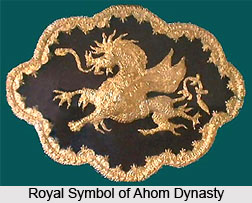 Sunyatphaa, also known as Udayaditya Singha, ruled over the Ahom kingdom from 1670 AD to 1672 AD. He succeeded the throne after the death of his elder brother Swargadeo Chakradhwaj Singha, in Ahom-Mughal war. His reign was marked by the end of Ahom-Mughal war in the battle of Saraighat which had started during the reign of his elder brother. However he failed to win against the Dafala tribes. Sunyatphaa had an over exerted devotion towards Paramananda Sanyasi which also aroused dissatisfaction among the nobles leading to his deposition and execution.
Sunyatphaa, also known as Udayaditya Singha, ruled over the Ahom kingdom from 1670 AD to 1672 AD. He succeeded the throne after the death of his elder brother Swargadeo Chakradhwaj Singha, in Ahom-Mughal war. His reign was marked by the end of Ahom-Mughal war in the battle of Saraighat which had started during the reign of his elder brother. However he failed to win against the Dafala tribes. Sunyatphaa had an over exerted devotion towards Paramananda Sanyasi which also aroused dissatisfaction among the nobles leading to his deposition and execution.
Reign of Sunyatphaa
When Sunyatphaa ascended the throne, Ahom Mughal war was at its height. The mughal army, under the commandership of Raja Ram Singh I was trying to capture Guwahati whereas the Ahom army under the leadership of Lachit Borphukan and Atan Burhagohain were bravely defeating them. A proposal was also sent by Ram Singh I that if the Ahom army surrendered the garrison of Guwahati, the Mughals would not proceed further beyond the boundary of Ahom kingdom. When Sunyatphaa discussed the proposal with his nobles, most of them agreed except the Prime Minister Atan Burhagohain who stated that the war and sacrifice of the Ahom army would be worthless if they surrendered before the Mughal army and thus the proposal was rejected. Mughal army retaliated to this by entering the plains of Guwahati through the Brahmaputra River in boats. Lachit Borphukan was severely ill at that time which caused the demoralization of the Ahom forces, who retreated without fighting in the absence of their leader. On learning about the scenario, Lachit Borphukan appeared in the battlefield and together with the Ahom army defeated the Mughals in the Battle of Saraighat. However, soon after the war Lachit Borphukan died owing to his illness.
Expedition against Dafala Tribe
Dafala tribe was the inhabitants of the hills of present day Lakhimpur district and Sonitpur district. They used to carry out marauding excursions, capturing Assamese people and their properties. Their activity was somehow checked by the Ahoms by granting them an amount of money. During this period, Dafalas complained about the delivery of the money and thus raided a village and killed a few Assamese. An expedition was sent by Sunyatphaa, led by Ghorakonwar Borbarua for capturing and punishing the Dafala raiders. He even threatened Borbarua that he would be killed if he returned without defeating the Dafalas. When the army reached their villages, they found it empty. But as they were about to return they were attacked by the Dafalas who were hiding in the neighbouring jungles. A number of Ahom soldiers were killed by the Daflas whereas many of them were chased down to the plains.
Paramananda Bairagi during the reign of Sunyatphaa
The reign of Sunyatphaa also witnessed the influence of Paramananda Bairagi, also known as Gakulpuri Sannyasi, on the king. Paramananda Bairagi came from Gakulpur near Brindaban and possessed the power of performing miracles that earned him a number of disciples. Sunyatphaa was also impressed by him and had brought him to the royal court. Not only he himself became a devotee but also ordered his nobles to become the disciple of the Sannyasi. The king had also summoned the Vaishnava Mahantas and asked them to become a disciple. When they refused king`s order, they were imprisoned. Debera Hazarika who was an Ahom officer resolved to curb this influence on Sunyatphaa and thus to safeguard the prestige of Vaishnava monks of Assam. Debera then gathered supporters of Sarugohain who was the younger brother of Sunyatphaa and instigated them for achieving the royal throne. Sarugohain along with his supporters arrived at the palace in November 1672 CE. When they were refused to enter the palace campus, they did it forcibly which led to a fight between the royal guards and the supporters of Sarugohain. When all the royal guards were killed and Sunyatphaa was captured, Sarugohain declared himself as the king.
Death of Sunyatphaa
After the capture of the throne by Sarugohain, Sunyatphaa was taken to Charaideo Hill and was put to death. According to some other sources he was imprisoned by Debera whereas his three wives were killed. Paramananda Sannyasi who unknowingly inflicted the revolution was arrested by Debera and Sarugohain. He was executed after being put to various insults and tortures.



















